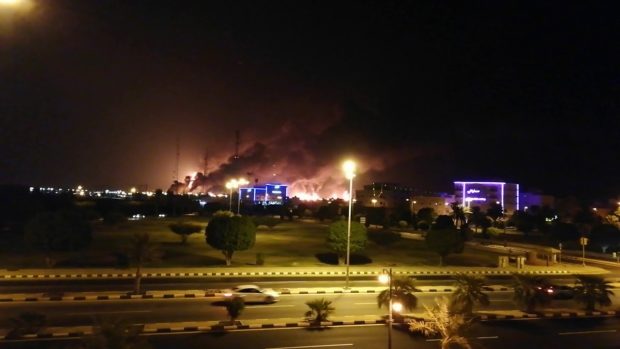
Major oil installations including the world’s largest processing facility were set ablaze by drone attacks in Saudi Arabia yesterday.
Houthi rebels in neighbouring Yemen claimed responsibility for strikes at the fields operated by the Saudi state oil company.
Footage showed a huge blaze at Abqaiq, site of Aramco’s largest oil processing plant, while flames could also be seen following a second drone attack in the Khurais oilfield.
The fires, which began in the early hours of yesterday, were under control at both facilities by the afternoon, state media said.
A spokesman for the Iran-backed Houthi group in Yemen said it had deployed 10 drones in the attacks.
The precise nature of the strikes was unclear last night but security analysts suspected the rebels had adapted commercially-available drones with explosives and crashed them into the oil facilities, or that they had obtained military drones from Iran capable of releasing missiles or guided bombs.
Wim Zwijnenburg, a drones expert at Dutch peace organization PAX, said the craft used in the attacks may have cost as little as £10,000 to build.
As well as being able to cause damage hugely disproportionate to their cost, he added the drones were hard to detect and shoot down.
He said they gave the rebels, who lacked significant financial resources, a way to hurt Saudi Arabia, which last year spent more than £50billion on arms. He said: “They are learning to adapt their drone capabilities to specifically attack Saudi targets, avoiding detection, avoiding interception, which means that in the future they have a larger set of targets to choose from.”
UN investigators believe the Houthis have obtained new high-tech drones with a range of 930 miles.
No one is believed to have been injured in the drone attacks but the impact on production at the facilities, which are crucial to global production, is being assessed. Saudi Arabia said an investigation was under way.
It is feared the strikes will heighten tensions across the Persian Gulf area amid the ongoing US dispute with Iran over its nuclear programme.
The Houthis are backed by Iran amid a Saudi-led war against them in Yemen. The strikes are believed to be in response to long-running attacks by the Saudi air force on targets in Yemen.
In a short address on the Houthi’s Al-Masirah news channel, spokesman Yahia Sarie said the rebels launched drones in co-ordinated attacks on the oil sites.
He warned attacks by the rebels would get worse if the war continues, adding: “The only option for the Saudi government is to stop attacking us.”
The official Saudi press agency said “security teams of Aramco started dealing with fires at two of its facilities in Abqaiq and Khurais as a result of drones” at 1am UK time.
It added yesterday: “The two fires have been controlled.”
Aramco describes its Abqaiq oil processing facility, 200 miles north of capital Riyadh, as “the largest crude oil stabilisation plant in the world”.
It’s estimated the plant can process up to seven million barrels of crude oil a day.

Enjoy the convenience of having The Sunday Post delivered as a digital ePaper straight to your smartphone, tablet or computer.
Subscribe for only £5.49 a month and enjoy all the benefits of the printed paper as a digital replica.
Subscribe